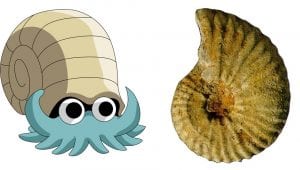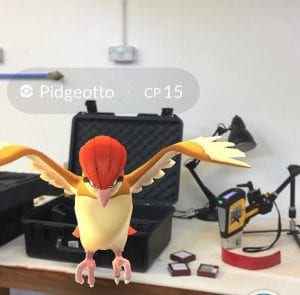Make a Museum about Pokémon!
By Josie Mills, on 21 November 2017

Post-it Note found on the visitor feedback board in the Petrie Museum of Egyptian Archaeology (if this was left by you – get in touch!)
While working in the Petrie Museum last week I glanced at the board reserved for visitor feedback, noticed this post-it and couldn’t resist taking a photo… As a child of the nineties I have a soft spot for Pokémon and have wholeheartedly embraced revival of the plucky little critters. I’ve particularly enjoyed the nostalgia of sharing the new games with my younger brother, Daniel; if only there were a degree in poké-studies!
Last year the app Pokémon Go made headlines world-wide and the presence of the virtual creatures in museums and archives was widely discussed within the heritage industry. Perhaps unsurprisingly, I’m team positive for Pokémon Go in museums, and the staff at UCL Museums have written some great blog posts on the subject. See this post by Grant Museum Manager Jack Ashby and Research Engager Arendse’s blog.
In fact, museums, archaeological ruins, and science labs also feature in the Pokémon games, serving as venues to transform fossils found in the wild into rare Pokémon. These Pokémon, like those mentioned in Arendse’s post, were inspired by real fossils, for example Omanyte from ammonites, and Aerodactyl from pterodactyl. My personal favourite is Relicanth, a fish bearing a close resemblance to the Lazarus species the coeleocanth!

Left: Omanyte (Image: Bulbapedia; Right: Ammonite (Image: British Geological Survey)
Omanyte and Ammonite
Here you can see the similarities between the shell of the Pokémon and the preserved ammonite Mantelliceras, which lived during the Late Cretaceous/Cenomanian period around 100 million years ago. This was a time when much of the Chalk in England formed and Cretaceous ammonite fossils are common in chalky areas of the South Coast. Interestingly fossil ammonites are often displayed ‘upside down’ (effectively with their head in the air!) whereas the Pokémon are orientated to move with their tentacles at the base, more like the original creatures.

Top: Aerodactyl (Image: Bulbapedia); Bottom: Pterodactyl (Image: Dinosaur Pictures)
Aerodactyl and Pterodactyl
Perhaps the most literal translation of the three are the obvious similarities between the Aerodactyl Pokémon and the extinct Pterodactyl, which lived during the Jurassic period 200-150 million years ago. The fossils on the game are rare and can only be found in certain areas; similarly pterodactyl fossils are also localised in real life, with most excavated from the Solnhofen limestone in Germany.

Top: Relicanth (Image: Bulbapedia); Bottom: Coelacanth (Image: Smithsonian)
Relicanth and Coelacanth
Even Relicanth’s name nods to the antiquity and mysterious-ness of the real-life fish the Coelacanth. The Coelacanth is a ‘Lazarus’ species, a term that refers to a taxon that was thought to be extinct but reappears again in the wild. The cryptic nature of the Coelacanth is reflected by the camouflage cartoon pattern of the Pokémon, a graphic allegory of the fish’s complex history!
Although the Pokémon hype has gradually dwindled, perhaps this message from our younger audience (or any nineties kids out there), highlights what we can take from Pokémon: the appeal of learning about animals and artefacts, the surprise of finding new things where you didn’t expect them, and the lure of encountering the rare and interesting.
More practically, specimens that have inspired both fossils and non-fossil Pokémon are on display across the Grant Museum. However, if anybody is interested in funding a museum solely about Pokémon, please get in touch: I know someone who might be suitable for curator *cough*…
 Close
Close


